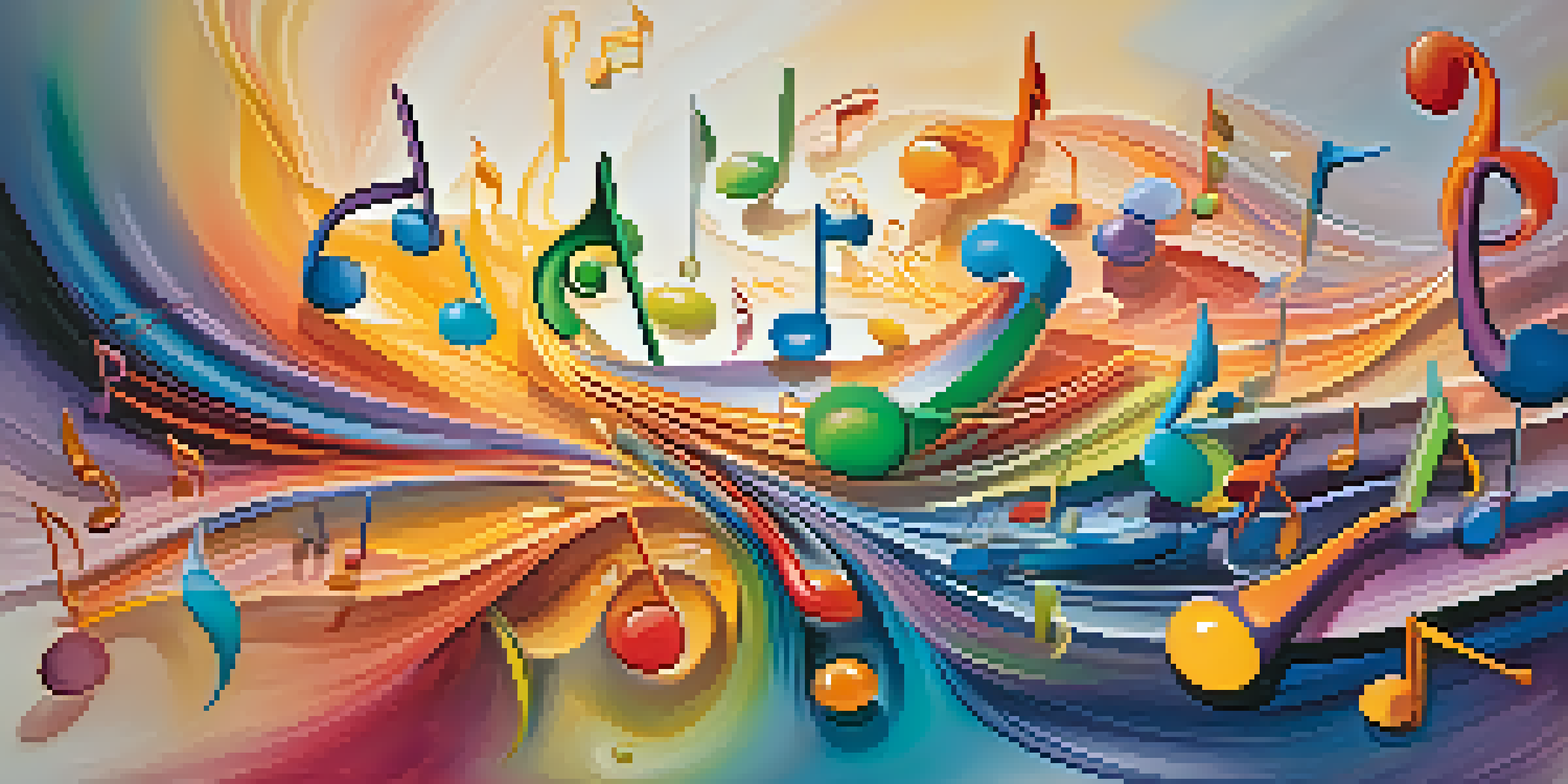Synesthesia: The Unique Perceptual Experience from Hallucinogens

What is Synesthesia? A Colorful Perceptual Phenomenon
Synesthesia is a fascinating neurological condition where stimulation of one sensory pathway leads to involuntary experiences in another. For example, someone with synesthesia might hear sounds and simultaneously see colors, creating a vivid and multi-sensory experience. This blending of senses can vary greatly among individuals, with some perceiving letters as colors or tasting shapes. The uniqueness of synesthesia lies in how it enhances the way some people perceive the world around them.
Synesthesia is a kind of multi-sensory experience that can reveal the extraordinary connections between our senses.
While synesthesia is often described as a rare condition, it actually exists on a spectrum, with many people experiencing mild forms of it. A common example is when individuals associate certain colors or feelings with specific numbers or letters, even if they don’t technically have synesthesia. This phenomenon raises interesting questions about perception, creativity, and how our brains process information. Understanding synesthesia can unlock insights into human cognition and sensory experiences.
Researchers continue to explore the neural mechanisms behind synesthesia, attempting to understand what makes certain individuals more susceptible to this condition. Some studies suggest that it might be linked to increased connectivity between sensory areas of the brain. The interplay between genetics and environmental factors also plays a crucial role, making synesthesia a compelling area of study within neuroscience.
The Connection Between Synesthesia and Hallucinogens
Hallucinogens, such as LSD or psilocybin mushrooms, are known to alter perception, often creating vivid and surreal sensory experiences. Interestingly, these substances can sometimes induce temporary synesthetic experiences, blurring the lines between senses just as true synesthesia does. For individuals without synesthesia, hallucinogens can unlock a new way of perceiving the world, leading to intense and multi-sensory experiences that feel both novel and profound.

The parallels between hallucinogenic experiences and synesthesia suggest that the brain’s sensory pathways may be more interconnected than previously understood. When under the influence of hallucinogens, users often report seeing sounds or tasting colors, mirroring the experiences of those who have synesthesia. This opens up exciting avenues for research into how altered states of consciousness can provide insights into the nature of perception and reality.
Synesthesia: A Unique Sensory Blend
Synesthesia is a neurological condition where stimulation of one sensory pathway leads to involuntary experiences in another, enhancing perception.
Moreover, studying the effects of hallucinogens on individuals with synesthesia can reveal more about the neural underpinnings of both phenomena. As researchers investigate these connections, they may uncover how certain compounds can enhance or mimic synesthetic experiences. This exploration not only contributes to our understanding of synesthesia but also enriches the dialogue surrounding the therapeutic potential of hallucinogens.
Synesthesia and Creativity: A Special Connection
Many artists, musicians, and writers have reported experiencing synesthesia, which often fuels their creativity. The blending of senses can inspire unique artistic expressions, resulting in works that evoke rich multi-sensory experiences. For instance, a musician with synesthesia might create melodies that resonate with specific colors, making their compositions feel more vibrant and alive. This unique perspective can lead to groundbreaking art and innovative ideas across various fields.
The experience of synesthesia suggests that our perception of reality is far more complex than we might have thought.
Famous figures like Wassily Kandinsky and Duke Ellington are known to have had synesthetic experiences that influenced their creative processes. Kandinsky, a pioneer of abstract art, believed in the emotional resonance of colors and sounds, which shaped his artistic style. Similarly, Ellington’s music reflects a deep connection between sound and visual imagery, showcasing the powerful interplay of senses in creative expression.
This connection between synesthesia and creativity prompts further exploration into how enhancing sensory experiences can benefit artistic endeavors. Understanding how synesthetes perceive the world can inspire new methods for fostering creativity in others. In a way, synesthesia may serve as a reminder that our senses can work together in harmonious ways, leading to richer and more expressive forms of art.
The Science Behind Synesthesia: Research Insights
Scientific research into synesthesia has gained momentum, with studies utilizing brain imaging techniques to uncover its underlying mechanisms. These investigations have revealed that synesthetes often show increased connectivity in brain areas associated with sensory processing. For example, the regions responsible for color perception may be more closely linked to those responsible for sound processing in synesthetes, leading to their unique experiences.
By examining the brains of synesthetes, researchers have discovered that the phenomenon may be rooted in a developmental quirk. During early brain development, some neural connections that typically become pruned may remain intact, allowing for the mixing of sensory pathways. This theory sheds light on why synesthetic experiences can vary so widely among individuals, as each person's brain may have a unique configuration.
Hallucinogens and Perception
Hallucinogens can induce synesthetic experiences, revealing the interconnectedness of sensory pathways and offering insights into altered states of consciousness.
As research continues to evolve, scientists are also exploring the potential applications of understanding synesthesia in various fields. Insights gained from studying synesthesia could improve educational strategies, enhance artistic practices, and even inform therapeutic approaches for individuals with sensory processing disorders. The more we learn about this captivating phenomenon, the more it illuminates the complexities of the human brain.
Hallucinogens and Their Role in Expanding Consciousness
Hallucinogens have been used for centuries in various cultures, often for spiritual or therapeutic purposes. These substances can induce altered states of consciousness, allowing individuals to explore deeper aspects of their psyche. The experience can lead to profound insights, emotional healing, and a sense of interconnectedness with the world. This exploration of consciousness is one reason why many people are revisiting the therapeutic potential of hallucinogens today.
Recent studies suggest that hallucinogens can promote neuroplasticity, enhancing the brain's ability to form new connections and pathways. This means that the use of hallucinogens might not only alter perception temporarily but could also have lasting effects on mental well-being. For individuals struggling with conditions like depression or anxiety, these substances could offer a new avenue for healing and self-discovery.
The connection between hallucinogens and synesthesia adds another layer to this exploration of consciousness. As individuals experiment with these substances, they may experience synesthetic-like effects, further blurring the lines between their senses. This intersection invites fascinating discussions about the nature of perception, creativity, and the potential for transformative experiences through altered states of consciousness.
Potential Therapeutic Applications of Synesthesia and Hallucinogens
The therapeutic potential of both synesthesia and hallucinogens is an exciting area of research that could lead to innovative treatment methods. Understanding how synesthetic experiences can promote emotional healing may help therapists create more effective strategies for their clients. For instance, art therapy could integrate the principles of synesthesia to enhance creative expression and facilitate emotional processing.
Additionally, hallucinogens are being studied for their ability to foster profound personal insights and emotional breakthroughs. By combining the insights gained from synesthesia with the therapeutic properties of hallucinogens, practitioners may develop unique approaches to mental health treatment. This integration could empower individuals to explore their emotions and experiences in new ways, potentially leading to lasting change.
Therapeutic Potential of Synesthesia
Understanding synesthesia and hallucinogens could lead to innovative therapeutic practices that promote emotional healing and creative expression.
As research in this field progresses, we may see the emergence of new therapeutic practices that harness the power of synesthesia and hallucinogens. This could pave the way for innovative treatments that prioritize holistic healing and personal growth. Ultimately, understanding these connections can help us appreciate the intricate relationship between perception, creativity, and mental well-being.
The Future of Synesthesia Research and Hallucinogenic Studies
The future of synesthesia research and studies on hallucinogens is promising, with ongoing investigations poised to yield groundbreaking insights. As technology advances, researchers are equipped with better tools to study the brain and understand the complexities of sensory perception. This could lead to a more comprehensive understanding of how synesthesia functions, as well as its implications for creativity and cognitive processing.
In parallel, the resurgence of interest in hallucinogens for therapeutic purposes has opened new avenues for research. As more studies are conducted, we are likely to see a clearer picture of how these substances can facilitate unique sensory experiences and promote psychological healing. The confluence of synesthesia and hallucinogens may provide a deeper understanding of consciousness and the potential for transformative experiences.

As scientists and clinicians collaborate, the insights gained from these studies could inform new approaches to mental health treatment and creative expression. The ongoing exploration of synesthesia and hallucinogens not only enriches our understanding of the human experience but also holds the potential to revolutionize therapeutic practices, ultimately benefiting countless individuals.